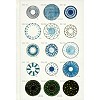Fembio Specials Famous Women from Hanover, Germany Hedwig Bollhagen
Fembio Special: Famous Women from Hanover, Germany
Hedwig Bollhagen

Born 10 November 1907 in Hanover
Died 8 June 2001 in Marwitz (near Berlin)
Most important German ceramicist of the 20th
115. birthday November 10, 2022
Biography • Literature & Sources
Biography
Hedwig Bollhagen was the child of a businessman and a mother who stimulated her daughter’s interest in modern art at an early age. A female friend of the family introduced Hedwig to the making of pottery during her school vacation. Her love of ceramics was also inspired by simple crockery at a farmers’ market.
After completing school in 1924 she studied and worked for several months in a small village pottery workshop in Hesse. Beginning in 1925 she spent five semesters at the Fachhochschule (technical college) Höhr-Grenzenhausen in the Westerwald. By the beginning of the 1920’s she had already come in contact with members of the Bauhaus, an institution which would influence her style. In 1927 Bollhagen was invited to work in the Steingutfabriken (earthenware factory) Velten-Vordamm in the vicinity of Berlin. Not yet 20, she became the supervisor of the more than 100 „Malmädchen“ (paint-girls). Her work in this position enhanced Bollhagen’s interest in the total production process of ceramics.
In view of the dire economic situation at the time Bollhagen decided to produce simple, affordable crockery. In 1934 she became artistic director of a ceramics workshop in Marwitz near Berlin. The former owner Margarete Heymann-Loebenstein was Jewish and had been forced by the Nazis to sell the operation for much less than its true value. The buyer and Bollhagen’s business partner, Heinrich Schild, was a member of the Nazi Party and a leading functionary of the alligned (“gleichgeschaltet”) organization of German crafts and trades (“Handwerk”); he eventually signed the firm over to her. Production began in Marwitz on May 1, 1934 with some 35 co-workers.
She resisted attempts by the Nazis to co-opt her and remained true to her own design principles. Working with the painter and ceramicist Charles Crodel, whom the Nazis had expelled from the Giebichenstein school of art and design in Halle as a maker of „degenerate art,“ Bollhagen experimented with new techniques. Moreover, she was tied to Crodel in what was probably the most important friendship of her life.
From 1946 to 1972 she maintained her workshops as a private enterprise, despite economic difficulties. During this time she used up her life insurance policy to pay wages. But she also quickly became the best-known ceramicist of the GDR. Pottery from Marwitz soon became so-called „under-the-counter“ ware, coveted rare goods obtainable only by those with good connections.
Hedwig Bollhagen continued working even after state control was implemented in 1972. In 1976 her facilities became part of the „Staatlicher Kunsthandel“ (State Art Trade) of the GDR. In 1990 they were a division of the Art Union GmbH, the successor to the GDR Kunsthandel. Reprivatization took place in 1992, and at 85, Bollhagen likely became Germany’s oldest entrepreneur. Hedwig Bollhagen died in Marwitz on June 8, 2001. She is buried in Hanover, the city of her birth.
transl. Joey Horsley
Author: Ulrike Henning
Literature & Sources
Degen, Angelika (2000): Hedwig Bollhagen gewidmet. Ein Besuch. Großpösna: Müller.
Dittmar, Monika (1997): Vollendung des Einfachen. Hedwig Bollhagen wird neunzig ; eine Ausstellung des Fördervereins Ofen- und Keramikmuseum Velten e.V. 1997. Velten: Förderverein Ofen- und Keramikmuseum (Baustein, 5).
Gorka-Reimus, Gudrun (Hg.) (2007): Hedwig Bollhagen. Ein Leben für die Keramik. Mit einem Vorwort von Dr. Angela Merkel. Deutsche Stiftung Denkmalschutz. Bonn: Monumente Publikationen.
Heger, Andreas (2005): Keramik zum Gebrauch – Hedwig Bollhagen und die HB-Werkstätten für Keramik. Weimar: VDG.
Keisch, Christiane (1993): Hedwig Bollhagen. Zum 85. Geburtstag. Ausstellung im Kunstgewerbemuseum, Schloss Köpenick, 23.12.1992 bis 31.3.1993. Berlin: Staatliche Museen Preussischer Kulturbesitz.
Steckner, Cornelius (2003): Hedwig Bollhagen – Charles Crodel. Briefe und Zeichnungen. Großpösna: Müller.
If you hold the rights to one or more of the images on this page and object to its/their appearance here, please contact Fembio.




